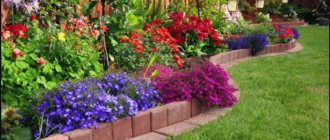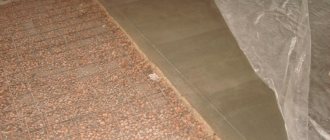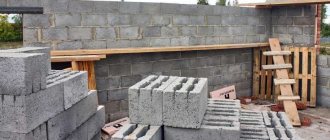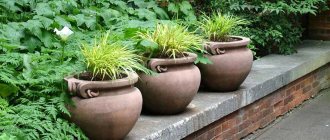Garden and country paths need improvement. This can be done in different ways: filling with gravel or expanded clay, laying tiles. There is another option: pouring concrete mixture. The result is a durable, strong, even street covering. If you wish, you can decorate it and get a high-quality imitation of wet stone, paving stones, or tiles. Let us understand all the intricacies of making garden paths from concrete with our own hands.
No. 1. What are the benefits of concrete paths?
Before installing concrete paths on your site, you need to know about all the advantages and disadvantages. The main advantages of paths made of concrete include:
- ease of installation, you can do everything yourself without the help of specialists;
- low price (compared to other options);
- the ability to manufacture any shapes and sizes if appropriate formwork is available;
- extensive decoration possibilities (adding pigment to the solution, using stone, mosaics and other decorations);
- strength and durability;
- resistance to the harmful effects of the environment (moisture, frost, etc.).
Among the disadvantages are:
- lack of possibility of redevelopment. Since this is a capital structure and it will be practically impossible to change the direction after the completion of the work, it is necessary to plan in advance both the structure itself and the entire surrounding area;
- the complexity of the preparatory work. In order for the design to be truly high-quality and reliable, you will need to put in enough effort and spend a lot of time preparing materials;
- occurrence of cracks. Sometimes in the off-season, soil shifts can occur, as a result of which the concrete structure can gradually collapse, including due to temperature changes.
If we compare concrete paths with other options in terms of advantages and ease of arrangement, then they win in many ways. Related to this is the desire to independently organize such trails on the site. Where to start and what to consider?
Advantages and disadvantages
Like any other surface, concrete roads have many advantages:
- strength, reliability, durability - the surface remains for decades;
- the surface can be easily given almost any configuration;
- affordable price - the cement, sand, water that makes up the coating cost very little;
- ease of installation - easy to create with your own hands, without special skills;
- high resistance to mechanical damage, wear resistance, even during active use;
- the material does not lose its qualities, even when exposed to harsh weather conditions - rain, wind, frost, heat, snow;
- the ability to fit a path into even the most complex terrain and garden design.
But there are also disadvantages:
- due to seasonal soil mobility, cracks often appear on the paths;
- a concrete surface is a permanent structure, its location is difficult to change;
- If done incorrectly, the path will ruin the appearance of the site.
No. 3. What tools and materials will be needed?
Before starting work, you should stock up on everything you need, namely:
- cement not lower than grade 300;
- sand;
- crushed stone;
- waterproofing additives for concrete;
- pieces of plywood, boards or metal to create formwork;
- wooden or steel pegs;
- sledgehammer or hammer for hammering in pegs;
- container for mixing the solution;
- a pair of shovels;
- steel construction mesh;
- smoother for leveling the surface of the path;
- trowels and spatulas.
No. 4. How to design a path?
The first thing you need to think about is where the paths will be located, who will move along them and when , what determines their width and shape. On paper, you can draw a site plan, indicate on it the location of all buildings and important areas, connect them with straight lines, which will be the axes for future paths. The paths can remain smooth and straight only between huge beds; in other cases, it is better to make them slightly curved to give the area an interesting look and make movement more comfortable and convenient.
The width of the path that leads from the gate to the central entrance of the house should be about 2 m, for auxiliary paths a width of 0.8-1 m is enough, between the beds you can arrange paths about 0.5 m wide. Those paths along which the car will move , should be no narrower in width than the car itself.
No. 5. How to correctly calculate the weight of building materials?
To avoid having to urgently purchase additional cement or sand during construction work, it is better to at least approximately estimate in advance the amount of materials that will be needed. The layer of concrete in different conditions may differ : for heavy clay soil - 5-7 cm, for sandy and light loamy soil - 10 cm. In addition, if the soil is swampy, then you need to provide a layer of gravel 5 cm thick. In any case, you will need a so-called cushion , which is made of sand and has a thickness of 10-15 cm.
The calculation of all the necessary materials is quite simple. Let's say it is necessary to build a path with a width of W = 1 m, a length of D = 10 m and a thickness of T = 10 cm (0.1 m), and the underlying layer of sand will be equal to P = 0.1 m:
- To organize a sand cushion, the required amount of sand is calculated as W*D*P. In our case, it turns out 1m*10m*0.1m=1m3. According to the reference information, the weight of a cubic meter of sand is 2400 kg, so 2400 kg is needed to complete the underlying layer;
- concrete can be prepared in the proportion of 3 parts sand and 1 part crushed stone, cement and water, but there are other options, which will be discussed later. It is more convenient to first calculate the volume of concrete required using the formula W*L*T, which comes out to 1m*10m*0.1m=1m3. According to reference information, the average weight of a cubic meter of concrete is 2800 kg. The resulting weight of the concrete volume can be divided into 5 parts, not taking into account water: 2800/5 = 560 kg - the weight of one part, i.e. cement. The rest 2240 kg is the weight of sand, crushed stone and water. You may also need dyes, plasticizers, water-repellent additives, etc.
Of course, this calculation does not pretend to be strictly mathematically accurate, but it allows you to approximately understand how much and what will be needed.
No. 6. How to markup?
Using a pre-prepared plan for the location of garden paths, it is necessary to determine directly on the ground where the paths will go. Their location is indicated by wooden pegs , which are driven in at equal distances from each other and a rope is pulled between them. This is the simplest and least labor-intensive stage of work.
conclusions
The garden path of their plastic bags can become a real decoration of any landscape design. It is versatile and can be combined with different styles. Making such a path with your own hands is quite simple. In manufacturing, it is recommended to use cement 500; it will provide the necessary strength of the coating. If necessary, you can always order ready-made concrete mortar. Inviting a large number of assistants who will quickly package the concrete into plastic bags will help optimize the process of laying the path. Adding color to the concrete solution will create a colorful garden path.
No. 7. How to prepare the soil?
At this stage, they begin to select the top layer of soil at the trail locations. The soil is removed along with small roots, which can begin to rot and form voids in which water can accumulate, and when it freezes and increases in volume, additional pressure will be exerted on the path.
If the layer of “cushion” of sand is 10 cm, and concrete - 10 cm, then taking into account that it is better for the path to rise 3-5 cm above the ground level , you will need to choose 10 cm + 10 cm - 3 cm = 17 cm of soil. If a drainage layer of gravel is needed, then you need to add another 5-10 cm to the resulting value. Select the soil layer using a shovel.
Design
The final result directly depends on how carefully the project is thought out and the necessary calculations are carried out. To do this you will need to do the following work.
- Choose a location for the path. It is better to lay it where a natural path has already formed: people always intuitively choose the optimal path.
- Make sure that the path does not pass under the crowns of large trees and under the eaves of the roofs. This will avoid damage to the canvas by tree roots and moisture from leaves or the roof dripping onto the concrete, which can damage the material.
- Decide on the shape and design.
- Decide what the width will be. If the area is small, forty centimeters is enough. However, if free space allows, it is better to make paths 60-80 centimeters wide.
- Consider the presence or absence of curbs. If you do not plan to install such elements, you will have to raise the road surface above the soil level. This will require additional work, but it will prevent the edges of the concrete structure from crumbling and protect it from subsidence.
No. 8. How to install formwork?
Formwork is a structure for pouring concrete. It is made of wood. If you want to make smooth lines or curves, you can always use plywood or other flexible material. The formwork is installed immediately or in parts, since the concrete is poured gradually. The second option will also save costs on materials.
The formwork should protrude 5-10 cm above ground level. It is necessary to lay a construction mesh at the bottom of the prepared trench, and every 5-6 m of the future path, install boards across it, which act as expansion joints . Thanks to them, the concrete path will not crack during temperature changes, placing stress on the boards. The height of the expansion joints must match the height of the track.
No. 9. How to arrange a pillow?
The so-called cushion under the concrete path performs several functions, the main ones:
- concrete load distribution;
- drainage.
The sandy base allows water to pass through well, which means that the soil under the path will not freeze, causing deformation of the path. Under the sand, many experts advise organizing a layer of compacted crushed stone, but this is not always necessary. Over time, sand can sink into the ground along with water passing through it, so it is better to lay a layer of waterproofing made of roofing felt, geotextile or agrofibre . The last two perform very well, as they do not rot and allow moisture to pass through perfectly.
The sand layer must be compacted well. You may have to wet it for this, since there should be no voids left inside. The surface must be level so that the concrete layer is distributed evenly. It is worth noting that an alternative to sand can be a concrete screed or flat stones, but their thickness must be taken into account when deepening the trench.
Tips and care recommendations
After a long winter, a long absence of owners from the dacha, concrete paths often require cleaning, repair, and restoration. On the surface, along the edges, cracks, gouges, chips, and pits form, which do not always add decorativeness to the coating, because over time the damage will become larger and grass will grow through them.
Experts advise the following:
- correct the edges of the canvas - clean the surface, treat it with a primer, apply formwork along the edges, cover up defects with concrete mixture;
- level the entire plane of the canvas - prime the surface, install the formwork, fill it with a semi-liquid solution until a flat surface is formed;
- large potholes are reinforced with metal mesh before filling;
- if the road is made of tiles, the broken fragments are replaced with whole ones, a little cement is poured under the sagging places, after removing the parts;
- when, instead of tiles, wooden cuts that have become unusable are embedded in concrete, the easiest way is to replace them with new ones, having previously been impregnated with hydrophobic compounds;
- weeds, even the smallest ones, that have grown near the path must be removed in time - their root system gradually destroys the surface;
- it is important to ensure that the paths are not washed away by water and to clear them of snow in a timely manner;
- Painted paths are periodically watered with a hose to prevent dust from accumulating.
All paths must be kept clean - this way they will last a long time, maintaining a beautiful appearance.
No. 10. Concrete preparation and mixing
There are no single correct proportions in the ratio of sand, cement, gravel, water and other components of concrete. As for the amount of water , the best option would be 1 part water to 4 parts cement, but as the composition is prepared, water can be added to improve plasticity.
For paths with light loads, you can choose a cement, sand and gravel ratio of 0.5:5:4. For car paths, a ratio of 1:1.5:2.5 is suitable. Many experts use a universal composition of durable concrete , where cement, sand and crushed stone are in a ratio of 1:3:1. Additives are also used to give the concrete the required qualities.
It is better to choose cement no lower than M300, river sand, crushed stone 10-20 mm in size. Granite is optimal. If the load on the paths is large, then you can take a larger crushed stone fraction of 40 mm. It is convenient to mix all the ingredients in a concrete mixer or mortar mixer , but if they are not available, any container such as a trough or just a large steel sheet will do. First, sand and crushed stone are mixed, then cement is added, and a gray mass is obtained. After this, add half of the required amount of water, mix, and then gradually add the rest of the water so that the composition becomes the desired consistency.
In theory, the thicker the concrete, the stronger it is, but thinner ones are easier to work with and distribute evenly. To simplify your task, you can add a little plasticizer , which makes the concrete more plastic and fluid without excess water.
Decoration methods
To make the path beautiful, various decor is used. The surface is made smooth or textured, plain or colorful.
There are several decorating options available:
- punching;
- hand dyeing;
- use of stencils, forms.
The easiest way is to imitate tiles. To do this, take a metal rod, with the help of which arbitrary lines are drawn, five to seven mm wide, imitating tiles. In other options, it is permissible to use stamps.
If you want to add bright colors to the landscape, the trails are painted in any color. To do this, use acrylic paints applied to hardened concrete. Sometimes dyes are added directly to the solution - this allows for volumetric painting.
The original shape of the roads itself will be the best decoration. If there is enough space in the garden, labyrinths of paths, many forks, and steps are made. “Living borders” and mixborders are often planted along paths. The “pedestrian paths” will easily be framed by rows of colored glass or plastic bottles and a mound of “luminous” pebbles.
Coloring
Concrete is painted with acid, acrylic compounds, and polyurethane varnishes. It is recommended to use special paints that penetrate deeply into the surface. In addition to color, they contain polyvinyl chloride, epoxy resins, and latex. A high-quality coating does not lose color for several years. The paint must be resistant to abrasion, fading in the sun, cracking, but at the same time breathable.
To apply paint you will need:
- iron brush;
- putty knife;
- brush, roller or spray;
- containers for dye;
- the dye itself;
- primer, putty for concrete.
A flat surface is simply swept, degreased, consisting of individual tiles - cleared of growing grass. It is permissible to paint at least a month after pouring concrete, at temperatures above +10 degrees. Next, with a difference of 12-15 hours, layers of paint are applied. It is recommended to paint a textured surface with a brush, a smooth surface with a roller, or with a spray gun - any kind.
Use of forms, stencils
Stencils and tile molds are usually made of plastic - the thicker it is, the more durable the product. Silicone options are less common; homemade ones are made of wood. The forms have a bottom, the stencils do not have one. When using these items, lubricating compounds are additionally used to prevent the finished tiles from sticking. If you want to diversify the design of the coating, take elements of different configurations. Many manufacturers produce stencil forms with several different cells.
Porcelain stoneware, multi-colored pebbles, plasticizers, etc. are often added to the composition of the tiles. Round stencils are easy to make from metal pipes cut into pieces of 8-12 cm, square, polygonal - from plywood, bars, metal. Sometimes molds are cast from silicone - to do this, take a suitable sample, place it in a bucket or formwork, pre-lubricated with grease, and fill the space between them with silicone from a tube.
The tiles made in a special way realistically imitate stone, brick, or wood surfaces. A mosaic is made from small tiles.
Stamping
An interesting way to decorate is stamped concrete. This is a concrete plane onto which stamping is applied using stamps (purchased or homemade).
The drawing usually imitates:
- tiles;
- leopard skin;
- brick;
- circles on the water;
- rock art;
- traces of human palms and feet;
- paw prints of animals and birds.
Before stamping begins, the concrete must acquire sufficient plasticity.
No. 11. Reinforcement and filling
Reinforcement or reinforcing mesh is laid on a sand bed, on top of which concrete is poured. The bottom of the trench can be additionally watered so that it does not sag under the weight of the concrete. The layer is leveled and compacted until the so-called cement laitance appears, which gives the concrete excellent strength characteristics and allows it to harden rather than dry out. In order for the concrete to harden and not dry , it is recommended to periodically wet the surface with water or cover it with polyethylene. Some even spread plastic film under the concrete, but this is not the best way.
To prevent water from accumulating on the paths in the future and forming puddles, you can make the central part of it a little higher than the side ones. The next day, when the solution has slightly hardened but is still soft, you can decorate the surface. For example, you can make furrows in a chaotic manner, imitating a stone surface. The next day, white or red colored cement mortar is poured into the furrows.











